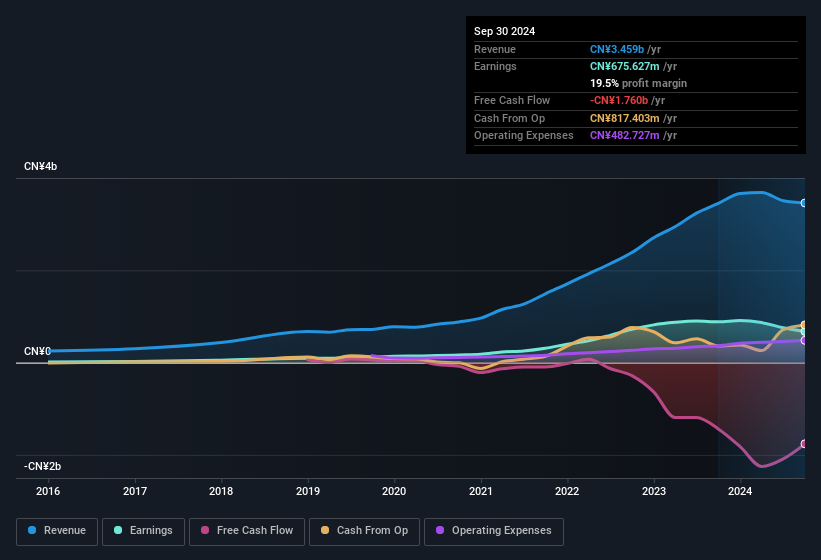- China
- /
- Semiconductors
- /
- SHSE:603290
StarPower Semiconductor's (SHSE:603290) Problems Go Beyond Weak Profit
Investors were disappointed by StarPower Semiconductor Ltd.'s (SHSE:603290 ) latest earnings release. Our analysis has found some reasons to be concerned, beyond the weak headline numbers.
See our latest analysis for StarPower Semiconductor

Zooming In On StarPower Semiconductor's Earnings
As finance nerds would already know, the accrual ratio from cashflow is a key measure for assessing how well a company's free cash flow (FCF) matches its profit. In plain english, this ratio subtracts FCF from net profit, and divides that number by the company's average operating assets over that period. This ratio tells us how much of a company's profit is not backed by free cashflow.
Therefore, it's actually considered a good thing when a company has a negative accrual ratio, but a bad thing if its accrual ratio is positive. While having an accrual ratio above zero is of little concern, we do think it's worth noting when a company has a relatively high accrual ratio. That's because some academic studies have suggested that high accruals ratios tend to lead to lower profit or less profit growth.
For the year to September 2024, StarPower Semiconductor had an accrual ratio of 0.42. Statistically speaking, that's a real negative for future earnings. To wit, the company did not generate one whit of free cashflow in that time. Over the last year it actually had negative free cash flow of CN¥1.8b, in contrast to the aforementioned profit of CN¥675.6m. We also note that StarPower Semiconductor's free cash flow was actually negative last year as well, so we could understand if shareholders were bothered by its outflow of CN¥1.8b.
That might leave you wondering what analysts are forecasting in terms of future profitability. Luckily, you can click here to see an interactive graph depicting future profitability, based on their estimates.
Our Take On StarPower Semiconductor's Profit Performance
As we discussed above, we think StarPower Semiconductor's earnings were not supported by free cash flow, which might concern some investors. For this reason, we think that StarPower Semiconductor's statutory profits may be a bad guide to its underlying earnings power, and might give investors an overly positive impression of the company. But on the bright side, its earnings per share have grown at an extremely impressive rate over the last three years. At the end of the day, it's essential to consider more than just the factors above, if you want to understand the company properly. So if you'd like to dive deeper into this stock, it's crucial to consider any risks it's facing. When we did our research, we found 2 warning signs for StarPower Semiconductor (1 makes us a bit uncomfortable!) that we believe deserve your full attention.
Today we've zoomed in on a single data point to better understand the nature of StarPower Semiconductor's profit. But there is always more to discover if you are capable of focussing your mind on minutiae. For example, many people consider a high return on equity as an indication of favorable business economics, while others like to 'follow the money' and search out stocks that insiders are buying. While it might take a little research on your behalf, you may find this free collection of companies boasting high return on equity, or this list of stocks with significant insider holdings to be useful.
New: Manage All Your Stock Portfolios in One Place
We've created the ultimate portfolio companion for stock investors, and it's free.
• Connect an unlimited number of Portfolios and see your total in one currency
• Be alerted to new Warning Signs or Risks via email or mobile
• Track the Fair Value of your stocks
Have feedback on this article? Concerned about the content? Get in touch with us directly. Alternatively, email editorial-team (at) simplywallst.com.
This article by Simply Wall St is general in nature. We provide commentary based on historical data and analyst forecasts only using an unbiased methodology and our articles are not intended to be financial advice. It does not constitute a recommendation to buy or sell any stock, and does not take account of your objectives, or your financial situation. We aim to bring you long-term focused analysis driven by fundamental data. Note that our analysis may not factor in the latest price-sensitive company announcements or qualitative material. Simply Wall St has no position in any stocks mentioned.
About SHSE:603290
StarPower Semiconductor
Researches, designs, develops, produces, and sells power semiconductor chips and modules in Asia and internationally.
Excellent balance sheet with moderate growth potential.
Market Insights
Community Narratives




